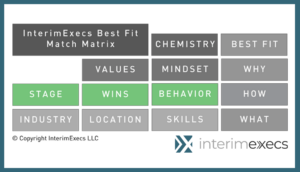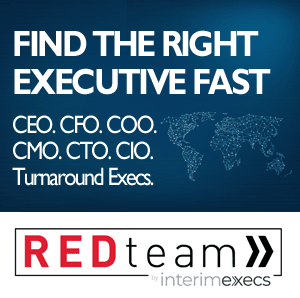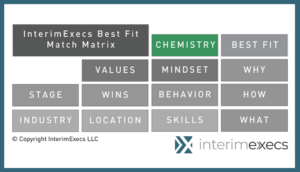Interim Executive Recruitment: Making the Right Match

Your Complete Guide to Interim Management — Chapter 6: How to Choose the Right Interim Executive
06: Interim Executive Recruitment: Making the Right Match
As one of the first companies to see the value in interim placements, we have years of experience showing us what works and what doesn’t. From that wealth of experience and the valuable data collected over years of interviewing Interims and clients, placing Interims on engagements and seeing first-hand results, InterimExecs created a repeatable framework that should be used by all organizations in assessing the fit of a particular Interim to their specific needs.
This framework outlines nine key areas of alignment that ultimately form the basis for finding the right match:
1. Industry
2. Location
3. Skills
4. Stage
5. Wins
6. Behavior
7. Values
8. Mindset
9. Chemistry
This diagram organizes the nine key areas of alignment as illustrated below, placing lowest value on the “what” criteria and higher value on “why” criteria, etc.
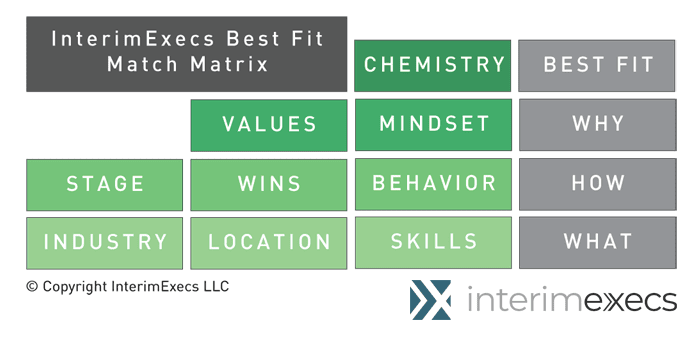
When assessing fit between a company and interim, InterimExecs looks at all nine levels with varying importance, ultimately working their way up to the holy grail: chemistry. The remainder of this chapter outlines these nine key areas of alignment, their importance, and how to assess fit.

The Complete Guide to Interim Management
-
- 01 What is an Interim Executive?
- 02 When is an Interim Manager the Right Choice?
- 03 When an Interim Executive is Not a Good Option
- 04 What’s the Difference Between an Interim Executive and a Consultant?
- 05 How do Interim Execs Approach Assignments?
- 06 Interim Executive Recruitment: Making the Right Match
- 07 The Process for Engaging an Interim Executive
- 08 How to Prepare Your Company for an Interim Leader
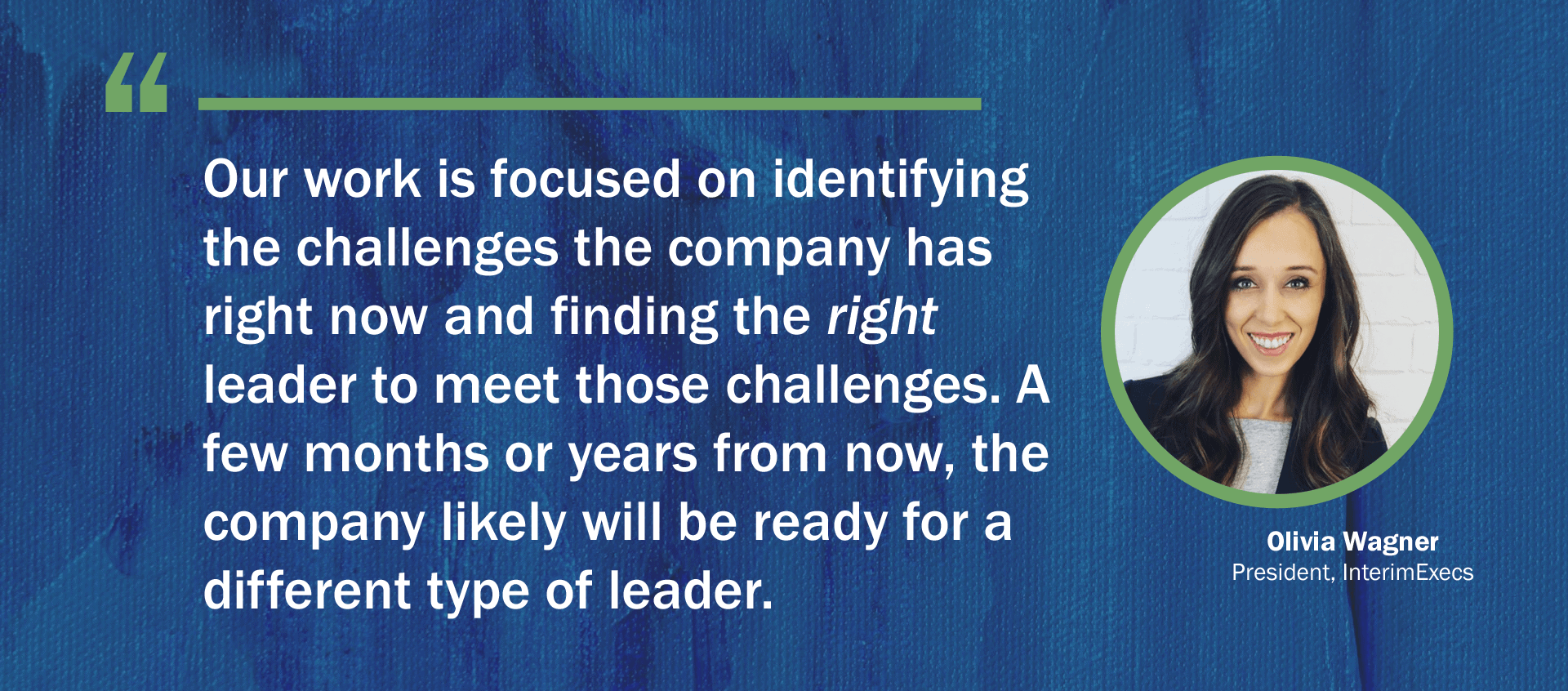
Best Fit Level 1: What
1. Industry
It is easy to assume that the interim executive with extensive experience in your industry will be the best fit for your company. Indeed, prior experience in your industry may be a positive. Industry-specific experience is a positive when the vast accumulation of knowledge from prior roles instantly becomes relevant in a new situation, crisis or opportunity. It also can come into play in navigating through highly regulated industries such as healthcare, insurance, finance and banking.
But there are situations when strong industry experience is a negative. That is especially true for industries facing significant transformation. The industry expertise is already within the company. What’s needed is fresh thinking and third party objectivity.
Consider a hypothetical example: executive A spent his entire career in the automotive industry. Executive B had increasing levels of authority in automotive and two other industries before becoming an interim executive.
In general, executive B could prove over time to be the better interim executive because cross-pollination from various industries serves to do two things:
• the executive is more likely to be well-rounded from learning different operating systems at different companies in different industries, and
• varied experience will mirror the executive’s range of capabilities in performing interim engagements.
2. Location
While some company owners still believe that having an executive onsite full-time is the only way to go, the advent of remote work and long-distance commuting has changed that reality for employees. And, thanks to the temporary nature of their work in the gig economy, interims are unlikely to relocate to live close to a job that may last for only a few months.
Many interims travel the world to take on great challenges and have the frequent flier miles to prove it. They go to the problem, challenge, or opportunity That could mean commuting to the company headquarters, finding temporary housing, working remotely, or some combination of those.
Don’t let location or an unwillingness to relocate keep you from engaging the best talent.
3. Skills
“Skills” refers to the executive’s experience across various functions within organizations — sales, operations, marketing, finance, and accounting — and the accumulated wisdom and track record the executive brings to a given engagement.
One of the biggest stumbling blocks for company owners is recognizing the difference between skills and industry experience. It is easy for a private equity fund manager or company owner to believe that an executive who has spent considerable time in a particular industry will be better equipped to enter another company in the same industry. Sometimes that is true – but not necessarily. Industry is not the same thing as skill building and track record.
Companies should focus on transferable skills – taking a company public, bringing about operational and supply chain improvements, expanding into international markets, setting up B2B or B2C sales teams. These explorations allow the client to share what needs to get done and assess if the interim has the ability to learn quickly to accomplish set goals.
Standard resumes paint very broad strokes regarding an interim’s qualifications, but add few meaningful insights that a prospective client will want to know. Interviews allow the opportunity to dive into bigger questions about where the company is at and where it wants to go in determining best fit.
Best Fit Level 2: How
4. Stage
Companies go through many different stages in their lifecycle. Launch, scaling up into new markets, organic growth, expansion through acquisitions, turnaround, and ultimately exit via sale, IPO or merger. Each stage requires a different interim with the cadence, mindset, and skillset needed to meet that stage.
There are hundreds of use cases for interims. Looking at examples of where interims have had success in the past, you can see that each exec has a “sweet spot” – a stage that they love jumping into and ramping up fast.
Have you ever met someone who specializes in turnarounds? The turnaround executive is fix-oriented: How do we save assets? What can we trim? This is a very different mindset from, say, an executive or entrepreneur who thrives on startups. The startup executive wants to know: How do we turn this acorn into a mighty oak tree? How do we go from zero to $1 billion in revenue?
Companies should look for similarities between their current stage and the experiences the interim has had at other companies, which can be as varied as:
● An interim grew a company from scratch to hundreds of employees
● An interim broke through a revenue/sales ceiling at $50 million
● An interim grew a division from $500M to $1B
● An interim created systems, technology, and processes across an entire organization.
5. Wins
There is a certain ineffable quality to a winner – think of any field of endeavor where you’re inspired by someone who has accomplished far more than average, and continues to demonstrate excellence time after time.
- Muhammad Ali
- John Glenn
- Warren Buffett
- Bill Gates
- Steve Jobs
It is not that the person was flawless, simply that they had the quality over time of winning.
Interims make their career by going into organizations for a short period of time, doing and delivering. If they cannot repeatedly produce wins, they are not cut out for a career in interim management.
Permanent executives can stay in roles for many, many years, and ride on the success of an established company. Interims do not have that luxury. They are going into fast-paced environments where markets and technology are evolving, innovation is needed, or new thinking is essential for survival. It is simply too important to leave to chance.
Owners need to see a winning track record to have confidence in their decision.
6. Mindset
Why do you do what you do?
We all have a “why” that drives us. InterimExecs uses a detailed process that helps us understand the “why” behind the most successful interims in the world; it is vital in weeding out people who may be looking at an interim assignment as a way to a full-time job, or those who are more interested in a paycheck than having major impact.
In some ways the interim management specialty goes against every notion of traditional employment. Human resources managers seek consistency. If an interim exec flashed a traditional resume, showing project after project at company after company, a traditional recruiter would peg them as a job hopper or question their competence.
This couldn’t be further from the truth. Interim executives choose this career, and routinely are asked by client companies to stay long-term, a request true interims are hard-wired to refuse.
Why would someone give up the stability of a full-time job for short assignments, which often are messy, require being on the road, and lead to constant change? It boils down to mindset.
Interim executives love challenge. They are really good at stepping into pivotal points in a company. But they are not so great at keeping things running smooth and steady for the long haul. It’s just not as fun. They get bored.
An interim executive who says they would be open to either interim or full-time work, is a permanent executive in disguise.
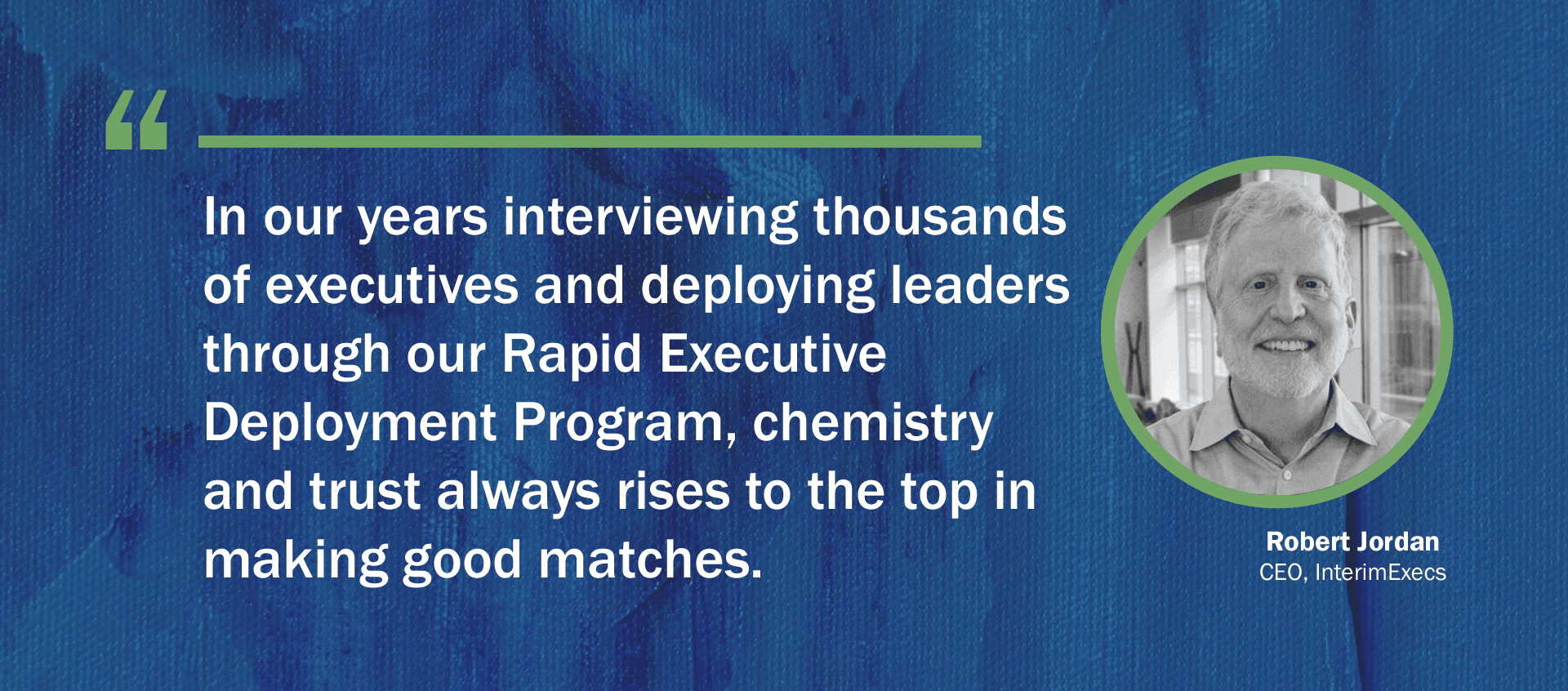
Best Fit Level 3: Why
7. Values
It goes without saying that a leader must have integrity. Yet, we need look no further than today’s news to see examples of leaders betraying trust or undermining their own organizations. Integrity is a condition of wholeness, of honoring one’s word and being true to an organization’s highest principles.
We value integrity above all else because if integrity is lacking on the part of the leader, we cannot trust their motives, intentions, or ability to do the right thing and produce the best result for the company.
Permanent employees can get entangled in corporate politics, trying to please the powers that be and keep their job secure. But on-demand interim executives tell the truth – even if it is not what everyone wants to hear. When determining fit with an executive, make sure you are confident that executive will do the right thing and advocate for what is in the best interests of the company. And be prepared to hear unpleasant truths.
8. Behavior
We each have an intuitive way we perform work. One interim described himself as a sprinter rather than a marathon runner. Another focused much of their time on empowering everyone around them to take responsibility so the company wouldn’t even notice they were gone after the assignment wrapped up.
With authentic interim executives, you will see a predisposition for action. Gauging how an executive would approach an assignment is key in seeing if they are a good fit for a particular situation.
To learn how an executive ramps up quickly and performs work on site, ask questions such as, “When you begin an assignment, what do you do on day one?” or “What does your process to assess the company and our current situation look like?”
Often described as conative fit, companies can formally measure the mode in which executives approach their work through tests like the Kolbe Profile, which focuses on how to form teams with complementary strengths in various work modes.
Entrepreneurs, for example, tend to have a dominant Kolbe trait called Quick Start where they make fast decisions with very little information. A financial analyst, on the other hand, could have a dominant trait in fact-finding and analytics, as opposed to rapid-fire decision-making.
An executive’s work mode can be instructive for the legacy team, but not necessarily conclusive.
9. Chemistry
This is the Holy Grail of executive matching. The other eight aspects of fit — industry, location, skills, stage, wins, behavior, values, and mindset — culminate in chemistry. Is there a good connection between the interim executive and the company’s owners? This measure is really a gut feel that no test can perfectly measure. But when it works, magic happens.
Continue Reading: Chapter 7 – How to Prepare Your Company for an Interim Leader

FREE DOWNLOAD
Top Trends Driving the Growth of Interim Management
▶ 5: How do Interim Execs Approach Assignments?
▶ 6: Interim Executive Recruitment: Making the Right Match
▶ 7: The Process for Engaging an Interim Executive
▶ 8: How to Prepare Your Company for an Interim Leader

